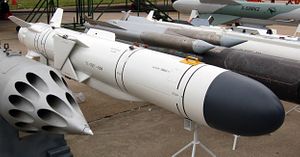North Korea has been exhibiting further signs of its militaristic tendencies this week, with mixed success. The release of propaganda material showing new cruise missile technology, and leader Kim Jong-un inspecting an obsolete Soviet-era diesel submarine, show the spectrum of wartime materiel that North Korea currently deploys. Russia’s recent forgiveness of Pyongyang’s debt is an indication of improved ties due to common interests, and could lead to a greater influx of modern military hardware into North Korea.
The U.S.-Korea Institute at Johns Hopkins University’s blog, 38 North, analyzed a recent North Korean propaganda film that featured a ship launching a cruise missile. Author Jeffrey Lewis compared the missile to an Indian Navy launch of a Russian-made KH-35 and found them to be externally identical. The KH-35 is a modern cruise missile designed in the 1980s and 90s to fly near the water’s surface and target ships. It also comes in land-based and helicopter-delivered variants. The article goes on to speculate as to where North Korea might have purchased the missile, with Russia being the most likely source, but countries like Myanmar also a possibility. The KH-35 can carry a 150 kg payload out to a range of 130 km.
In addition to this display of new, modern cruise missile technology, the Workers Party newspaper Rodong Sinmun released photos this week of Kim onboard a Romeo-class submarine designed by the Soviet Union in the 1950s. This class of submarine makes up a third of the North Korean fleet, and the vessel Kim was photographed on did not portray the usual image the government tries to project, but instead showed visible signs of age and rust in the same image as the new leader.
Apart from this uneven display of North Korea’s military prowess, it must be remembered that in April Russia wrote off nearly $10 billion in debt for Pyongyang, with the remaining balance of $1.09 billion to be paid back, but also reinvested in mutually beneficial projects like gas and rail infrastructure. Russia has recently signed a huge natural gas deal with China and is seeking to do the same thing on the Korean Peninsula, to further tap the Northeast Asian energy market and hedge its bets amidst worsening ties with its energy partners in Europe following its incursions into Ukraine.
North Korea will be a willing partner as long as deals to forgive its debt, and possibly receive new missile technology, are on the table. Kim’s unusual public appearance aboard an antiquated piece of North Korea’s naval arsenal not only highlights the state of large portions of Pyongyang’s military, but may also be a signal to neighboring countries that it is not an immediate or all-encompassing threat. Any pipeline or other infrastructure that passes through North Korea to reach South Korea or Japan will be a tool the North could use as leverage in raising or lowering tension on the peninsula, a longstanding tactic of North Korean leadership.

































